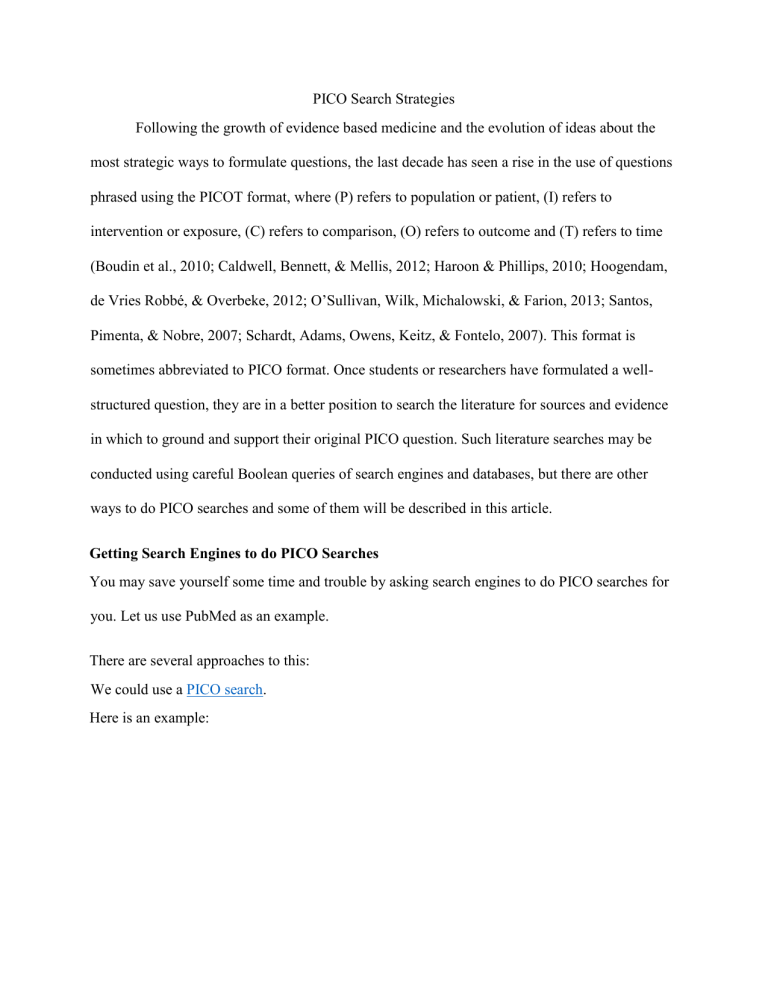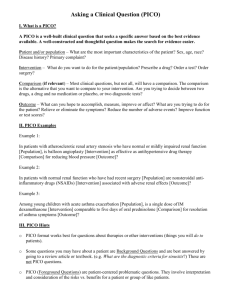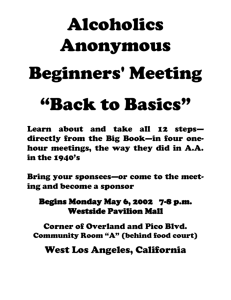PICO Search Strategies: A Guide for Researchers

PICO Search Strategies
Following the growth of evidence based medicine and the evolution of ideas about the most strategic ways to formulate questions, the last decade has seen a rise in the use of questions phrased using the PICOT format, where (P) refers to population or patient, (I) refers to intervention or exposure, (C) refers to comparison, (O) refers to outcome and (T) refers to time
(Boudin et al., 2010; Caldwell, Bennett, & Mellis, 2012; Haroon & Phillips, 2010; Hoogendam, de Vries Robbé, & Overbeke, 2012; O’Sullivan, Wilk, Michalowski, & Farion, 2013; Santos,
Pimenta, & Nobre, 2007; Schardt, Adams, Owens, Keitz, & Fontelo, 2007). This format is sometimes abbreviated to PICO format. Once students or researchers have formulated a wellstructured question, they are in a better position to search the literature for sources and evidence in which to ground and support their original PICO question. Such literature searches may be conducted using careful Boolean queries of search engines and databases, but there are other ways to do PICO searches and some of them will be described in this article.
Getting Search Engines to do PICO Searches
You may save yourself some time and trouble by asking search engines to do PICO searches for you. Let us use PubMed as an example.
There are several approaches to this:
We could use a PICO search .
Here is an example:
This will give a yield like:
You will notice there are 161 results and I have highlighted Handhelds in pink. This means that you can do these searches on your mobile phone, using the PubMed4Hh app. The iPhone app is here , and the Android app is here . Then, if you think about it, there are some easy ways to get your search results into Word.
We could try another approach by using askMedline using natural language.
and here are some results:
Alternatively, you may wish to try Consensus Abstracts (this will use a PICO search strategy)
Other Databases
There is the TRIP database at http://www.tripdatabase.com/
Which yields some interesting results with previews:
Then there is one of the academic favorites, Google Scholar:
Here we just enter the query in PICO syntax, e.g. (female)(mammography)(no mammography)(reduced mortality)
This PICO syntax will work in Google too and Microsoft Academic Search.
Library Databases
If you have access to an academic center library or to an institutional library, likely you will be able to search many different types of databases, including Science Direct, ProQuest,
Ebscohost, and Web of Knowledge.
Using the same PICO syntax e.g. (female)(mammography)(no mammography)(reduced mortality) you will be pleased to discover many relevant sources for your PICO search queries.
Occasionally, the syntax will not be fully compatible with a specific database. For example,
Ebscohost databases will often report: Your initial search query did not yield any results.
However, using SmartText Searching, results were found based on your keywords .
If you are pressed for time and need a literature base to support writing an assignment, formulating a research proposal, or simply looking for the best evidence to support a specific approach to intervening with a known population, you may find these PICO search strategies of great value.
References
Boudin, F., Nie, J.-Y., Bartlett, J. C., Grad, R., Pluye, P., & Dawes, M. (2010). Combining classifiers for robust PICO element detection. BMC Medical Informatics and Decision
Making , 10 , 29. doi:10.1186/1472-6947-10-29
Caldwell, P. H. Y., Bennett, T., & Mellis, C. (2012). Easy guide to searching for evidence for the busy clinician. Journal of Paediatrics and Child Health , 48 (12), 1095–1100. doi:10.1111/j.1440-1754.2012.02503.x
Haroon, M., & Phillips, R. (2010). “There is nothing like looking, if you want to find something”
- asking questions and searching for answers - the evidence based approach. Archives of
Disease in Childhood. Education and Practice Edition , 95 (2), 34–39. doi:10.1136/adc.2009.161570
Hoogendam, A., de Vries Robbé, P. F., & Overbeke, J. P. M. (2012). Comparing patient characteristics, type of intervention, control, and outcome (PICO) queries with unguided searching: A randomized controlled crossover trial. Journal of the Medical Library
Association , 100 (2), 121–126. doi:10.3163/1536-5050.100.2.0
O’Sullivan, D., Wilk, S., Michalowski, W., & Farion, K. (2013). Using PICO to align medical evidence with MDs decision making models. Studies in Health Technology and
Informatics , 192 , 1057.
Santos, C. M. da C., Pimenta, C. A. de M., & Nobre, M. R. C. (2007). The PICO strategy for the research question construction and evidence search. Revista Latino-Americana de
Enfermagem , 15 (3), 508–511. doi:10.1590/S0104-11692007000300023
Schardt, C., Adams, M. B., Owens, T., Keitz, S., & Fontelo, P. (2007). Utilization of the PICO framework to improve searching PubMed for clinical questions. BMC Medical
Informatics and Decision Making , 7 (1), 16. doi:10.1186/1472-6947-7-16



